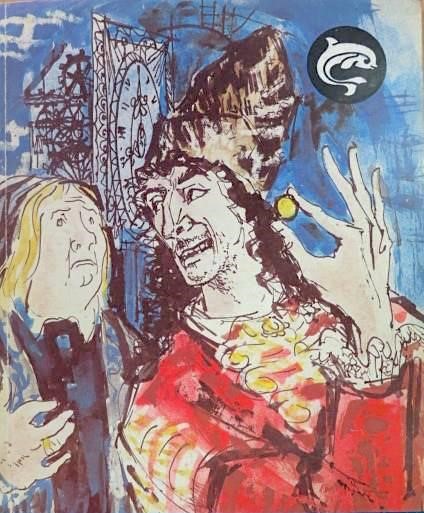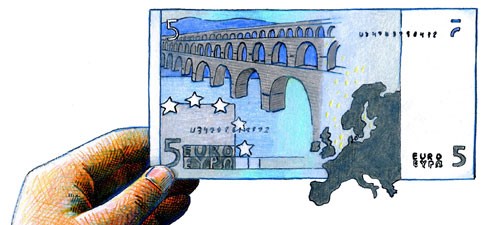As Old as the Use of Money? – Thoughts about the Regulation of Counterfeiting Currency in the Light of the International and EU Expectations
 It is doubtless that counterfeiting is historically coeval with the existence of money, as Karl Binding, a German legal scholar stated at the beginning of the 20th century, that: „invention of the money leads to the invention of counterfeiting.” (Binding, 1904, 306.) To the commission of a crime like this, mostly competent specialists, technicians and experts of computer systems are needed (Nagy & Tóth, 2015, 165.). But the build-up network cannot be neglected beside the suitable technical infrastructure, since organised criminal networks diffuse counterfeit currency in the whole world and we can say that, by now – apart from unique cases – it is a global and organised crime (Musacchio, 2016, 15.).
It is doubtless that counterfeiting is historically coeval with the existence of money, as Karl Binding, a German legal scholar stated at the beginning of the 20th century, that: „invention of the money leads to the invention of counterfeiting.” (Binding, 1904, 306.) To the commission of a crime like this, mostly competent specialists, technicians and experts of computer systems are needed (Nagy & Tóth, 2015, 165.). But the build-up network cannot be neglected beside the suitable technical infrastructure, since organised criminal networks diffuse counterfeit currency in the whole world and we can say that, by now – apart from unique cases – it is a global and organised crime (Musacchio, 2016, 15.).
The Origins of Counterfeiting Currency
Counterfeiting represents a considerable criminal weight, since the right to coinage and to issue money has always belonged to the privileges of the state. Its risky nature lies in the fact that it harms interests of economy, the legitimate amount of money in circulation, and affects the trust and confidence towards state-issued money as well. Moreover, a big amount or value of counterfeit currency may have even more serious consequences: these may jeopardize the balance of the finances in the traffic and the stocks fund (Belovics & Molnár & Sinku, 2019, 545.).
The crime of counterfeiting currency has a long history, counterfeit money has appeared before the coinage of money, which can be proved by the legal sources and the archeological findings (Tóth, 2016, 137.). Ancient civilisations already punished the crime like fraud, and later on, it was regulated separately, individually. The seeds of counterfeiting in criminal law can already be discovered in the ancient Greek and Roman law. Among the ancient Greeks, it was Solon and in Rome, Marius Graditianus was the first who made a law against counterfeiters. The latter also established investigation offices which controlled the genuineness of the money (Tóth, 2017a, 44.). Under the reign of Constantine appeared the concept that the counterfeiter with his or her conduct breaches the monarch and with this he or she commits treason, disloyalty.
The concept remained for centuries in the European countries in the Middle Ages. Due to this, the customary law (e.g. the Sachson Spiegel) and the written law (e.g. the Consitutio Criminal Carolina) said it shall be punishable by cruel sanctions (Tóth, 2015a, 656.). In the 18th century, as the ideas of the Enlightenment took hold, this concept started to change and counterfeiting currency was reclassified gradually as a crime against property. Cesare Beccaria was the first who denied the public law characteristics of the crime. (Angyal, 1940, 33.). The punishments became more humane and the main sanction was imprisonment.
The Brief Legal History of Counterfeiting Currency in Hungary
From the Beginning of the Evolution to the ‘Code Csemegi’
At the beginning of the legal development in Hungary, counterfeiting currency was punishable by the customary law and no regulations on the subject of counterfeiting can be found from the time of our first kings. The first written source is linked to the age of the reign of Andrew (András) III in the 13th century. Later it appeared in more acts like in the reign of Charles Robert (Károly Róbert) and in the acts of Matthias (Mátyás) I, in the age of the reign of which, counterfeiting was expressis verbis stated that, as a disloyalty crime, just as in other countries in the Middle Ages, the punishment was death for the perpetrators (Tóth, 2014a, 179.)
The Tripartitum – which never came into effect as an Act but as a customary law compilation, the courts applied it through almost three centuries and was published in 1517 (Lábady, 2002, 81.) – defined the legal practice, which, for centuries regarded counterfeiting as treason (Tóth, 2002, 322.). The 16th century could be described as the ‘Golden Age’ of the counterfeit currency makers, as the chaotic period definitely facilitated their activities (Tóth, 2018, 32.). The Act IX of 1723 – which also maintained the public law nature of the crime and it did not comply with the expectations of its age – also mentioned counterfeiters and put extremely strict sanctions into action against the perpetrators including forfeiture of property and capital punishment, if the counterfeiting was committed in excess of 50 Forints (Angyal, 1940, 10.).
Even the proposals for creating a Hungarian Criminal Code around the turn of the 19th century dealt with the crime of counterfeiting currency in detail (see Szabó, 2018, 150.). According to the most progressive attempt in 1843 – which shared the fate of the previous ones and never came into effect – counterfeiting currency was a crime against property and not against the monarch and sanctioned it with 12 years imprisonment (it should be noted that the proposal had no capital punishment at all). In addition, it declared the counterfeiting of banknotes (paper money) as forgery of administrative and public documents (Tóth, 2002, 372.).
From the ‘Code Csemegi’ to the Former Criminal Code – Among Emerging International Expectations
Our first Criminal Code, Act V of 1878 – which is also called the ‘Code Csemegi’ after its author, the famous Hungarian lawyer – regulated the legal definition of counterfeiting currency in altogether ten sections in its Chapter IX as a crime against public trust (Gula, 2017, 92.) (although, during the preparation of the Code, the legislators still thought it necessary to mention the royal criminal nature of the crime as well, Goricsán, 2011, 233.) The Code punished ‘actual counterfeiting’, along with the issue of counterfeit money and its acquisition with the same intentions (in other words, the ‘turnover of counterfeit money’), as well as fraudulent usage of counterfeit money and issue of counterfeit money (Finkey, 1914, 752.) and abolished the death penalty against counterfeiters. Act XXXVI of 1908 (the ‘first Criminal law Novelle’) amended the Code and particularly the categories of counterfeiting currency with the addition of the crime and act of unauthorised issue of banknotes (Tóth, 2014b, 258.). Act V of 1961 on the Criminal Code classified counterfeiting currency as a crime against the national economy and regulated it with the crime of stamp forgery.
The legislations formed in the field of counterfeiting currency, following the Geneva Convention – adopted in 1929 and entered into force in Hungary with the Act XI of 1933 – amended with provisions of international nature, regarded that foreign currency shall be subject to the same protection as the domestic currency (Gula, 2017, 92.). It should be recalled that in Europe, the interest in the transnational counterfeiting of currency was only really perceived as a problem after a couple of major counterfeiting cases in the period between 1920 and 1930 (Manas, 2017, 8.). France, for example, became the victim of large-scale counterfeiting of French francs in Hungary, which had already been the scene of counterfeiting Yugoslavian and Czechoslovakian currency, but the scandal involving the French francs was a major one, due to high-level political participation in the counterfeiting case and the ensuing lenient treatment of the perpetrators (Papp, 2013, chapitre ’Quand le « bloc chrétien » hongrois voulait ruiner le franc’, pp. 91–102.). Despite arrests made in the Netherlands and court cases conducted in Hungary, the outcome gave rise to considerable dissatisfaction, the sanctions were considered too light and a number of high-ranking civil servants and politicians were not prosecuted.
This resulted in actions by several countries to regulate the problem in the framework of the League of Nations, the predecessor of the United Nations, as it was a known fact that the counterfeiting of foreign currency was not a punishable offense in every country. In the eyes of those taking the initiative, by taking the matter to the League of Nations, the counterfeiting currency would be elevated to the level of a crime against the international legal order. The League of Nations produced an excellent comparative law report, which took into account criminal law, criminal procedural and international criminal law, and elaborated a draft Convention. In conclusion, the result was limited to the approval and ratification of the International Convention for the Suppression of Counterfeiting Currency (signed in Geneva on April 20, 1929), which can be regarded as a balance between the necessity to internationalise the crime of counterfeiting currency and the political duty to respect the legislative autonomy of the sovereign states (Vervaele, 2002, 155–156.). Even today, the Convention is the most important multilateral international convention regarding the suppression of counterfeiting money and contains a lot of provisions regarding cooperation in criminal matters. It is the basis of the European Union’s legal sources and it prescribes for the signing states that the foreign currencies shall not be discriminated by the aspect of criminal law protection (Tóth, 2018, 112–113.)
The Former Criminal Code – by Virtue of the Beginning of the EU Expectations
 Act IV of 1978 on the Criminal Code further simplified the regulation and regulated counterfeiting currency in the chapter under the title “Criminal Offences Against the Economy” (Goricsán, 2010, 35.). The criminal law concept of money was defined in a separate legislative decree (Law Decree V of 1979). In accordance with the provisions of the relevant 2000/383/IB Council Framework Decision – in which the EU prescribed for the first time legal harmony obligations to the Member States to effectively protect the euro currency which was introduced in 2002 (Klimek, 2012, 12.) – Act CXXI of 2001 amended the legal definition of counterfeiting currency in the Criminal Code (Section 304) and extended the scope of criminal conducts with importing, exporting counterfeit or falsified currency or transporting those in transit through the territory of Hungary.
Act IV of 1978 on the Criminal Code further simplified the regulation and regulated counterfeiting currency in the chapter under the title “Criminal Offences Against the Economy” (Goricsán, 2010, 35.). The criminal law concept of money was defined in a separate legislative decree (Law Decree V of 1979). In accordance with the provisions of the relevant 2000/383/IB Council Framework Decision – in which the EU prescribed for the first time legal harmony obligations to the Member States to effectively protect the euro currency which was introduced in 2002 (Klimek, 2012, 12.) – Act CXXI of 2001 amended the legal definition of counterfeiting currency in the Criminal Code (Section 304) and extended the scope of criminal conducts with importing, exporting counterfeit or falsified currency or transporting those in transit through the territory of Hungary.
The legislator created the legal definition of aiding in counterfeiting operations (Section 304/A) as well, which punished production, obtainment, keeping, transfer, distribution or trading of any material, means, equipment or computer programme necessary for counterfeiting currency. In addition, in the legislation regulating money, the legislator changed the provisions specifying the concept of money, thereby granting the Euro protection equivalent to that of the domestic currency (See Act CCXXIII of 2012).
The Effective Criminal Code
Act C of 2012 on the Criminal Code brought about new features also in the regulation of the legal provision of counterfeiting currency. One of these changes is that the legislator created a new, separate chapter under the title “Criminal Offences Relating to Counterfeiting Currencies and Philatelic Forgeries”, with the following criminal offences: counterfeiting currency, aiding in counterfeiting operations, forgery of stamps and other criminal offences related to cash-substitute payment instruments – which used to be regulated among the “Criminal Offences against the Economy” in the former Criminal Code. It should be noted that, according to some authors, even though the Economic Crimes chapter does not exist in the effective Criminal Code, from a criminological aspect, counterfeiting currency is still considered as an economic crime. (Tóth, 2018, 124.)
Another substantial change is that – with reference to the Framework Decision – the new Criminal Code rejected to regulate the case in which the object of counterfeiting is coinage or the quantity or value involved is trivial or even less substantial as privileged, as it has been regulated by the previous legislation (former CC Section 304 (3)). Similarly, the new Criminal Code abolished the individual legal definition of disbursement of counterfeit currency (former CC Section 306), as well as increased the sentence of both the preparation and the qualified case.
Examining the legislation, it is worth to point out the individual legal definition of aiding in counterfeiting operations, which was created explicitly for legal harmonisation reasons, and which gave rise to numerous critiques. According to several opinions, the creation of the sui generis delictum was not necessarily required, since the application of the Hungarian provisions related to preparation, which being specified in the general part would have complied with the EU requirements as well (Gula, 2004, 108–142). This opinion is also supported by the fact that, concerning Article 3 of the Geneva Convention, the aforementioned Framework Decision did little else than taking over the conducts of typically preparatory nature and simultaneously amended it with a reference to the technical achievements of our era (Jacsó, 2008, 489.).
The distinction of aiding in counterfeiting operations from the preparation for counterfeiting currency is also problematic (Molnár, 2014, 772.); the intent of the perpetrator cannot be directed at committing counterfeiting currency since in that case preparation for counterfeiting currency would be established. Moreover, since its introduction, the practice has also proven that the legal definition of aiding in counterfeiting operations was unrealistic; the number of registered cases per year ranges between zero and two – since the entry into force of the new Criminal Code, the authorities registered 2 cases in 2013, 1 case each in 2017 and 2019 and none in the other years – and the currently effective 2014/62/EU Directive – which replaced the earlier Council Framework decision and established minimum regulations regarding criminal law for the Member States (see Tóth, 2015b, 324–332) – also no longer makes the creation or sustaining of legal definition necessary (Gula, 2016, 173.).
In summation, it can be established that although the legislation of counterfeiting currency complies with the international and the EU legal sources and proves to be relatively time-resistant, fine-tunings by the legislator would have a favourable effect on enhancing the protection of the legal subject (Tóth, 2017, 549.).
For a list of references, click HERE.
Author: dr. Petra Ágnes Kanyuk
Ph.D. Student at the Géza Marton Doctoral School of Legal Studies of the University of Debrecen, Department of Criminal Law and Criminology
The study was prepared with the professional support by the Research Scholarship for Ph.D. Students No. ÚNKP-19-3, granted by the Ministry for Innovation and Technology in the framework of the New National Excellence Programme.

Sources for the images used:
Book cover of: Szombathy, Viktor (1969). A pénzhamisító. Budapest: Móra Ferenc Könyvkiadó
https://www.professionalsecurity.co.uk/news/government/euro-counterfeits/ [accessed April 18, 2020]